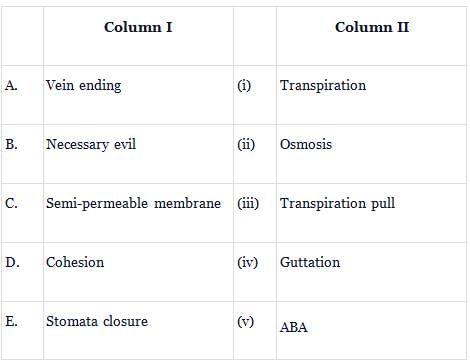Grade 12 Exam > Grade 12 Tests > Biology for Grade 12 > Test: Transpiration (Old NCERT) - Grade 12 MCQ
Test: Transpiration (Old NCERT) - Grade 12 MCQ
Test Description
5 Questions MCQ Test Biology for Grade 12 - Test: Transpiration (Old NCERT)
Test: Transpiration (Old NCERT) for Grade 12 2024 is part of Biology for Grade 12 preparation. The Test: Transpiration (Old NCERT) questions and answers have been
prepared according to the Grade 12 exam syllabus.The Test: Transpiration (Old NCERT) MCQs are made for Grade 12 2024 Exam. Find important
definitions, questions, notes, meanings, examples, exercises, MCQs and online tests for Test: Transpiration (Old NCERT) below.
Solutions of Test: Transpiration (Old NCERT) questions in English are available as part of our Biology for Grade 12 for Grade 12 & Test: Transpiration (Old NCERT) solutions in
Hindi for Biology for Grade 12 course. Download more important topics, notes, lectures and mock
test series for Grade 12 Exam by signing up for free. Attempt Test: Transpiration (Old NCERT) | 5 questions in 5 minutes | Mock test for Grade 12 preparation | Free important questions MCQ to study Biology for Grade 12 for Grade 12 Exam | Download free PDF with solutions
Test: Transpiration (Old NCERT) - Question 1
The bulliform cells of leaves lose their turgidity during excessive
Detailed Solution for Test: Transpiration (Old NCERT) - Question 1
Test: Transpiration (Old NCERT) - Question 2
Match column-I with column-II and select the correct option from the codes given below.


Detailed Solution for Test: Transpiration (Old NCERT) - Question 2
| 1 Crore+ students have signed up on EduRev. Have you? Download the App |
Test: Transpiration (Old NCERT) - Question 3
The given figure shows two states of a stomata.

In which of the conditions (i) and (ii), guard cells will have higher water content?

Detailed Solution for Test: Transpiration (Old NCERT) - Question 3
Test: Transpiration (Old NCERT) - Question 4
Amphistomatic leaf, with stomata distributed equally on both the surfaces, is an example of
Detailed Solution for Test: Transpiration (Old NCERT) - Question 4
Test: Transpiration (Old NCERT) - Question 5
Loss of water in the form of vapours from the living tissues of aerial plant parts is called
Detailed Solution for Test: Transpiration (Old NCERT) - Question 5
|
122 videos|161 docs|138 tests
|
Information about Test: Transpiration (Old NCERT) Page
In this test you can find the Exam questions for Test: Transpiration (Old NCERT) solved & explained in the simplest way possible.
Besides giving Questions and answers for Test: Transpiration (Old NCERT), EduRev gives you an ample number of Online tests for practice
|
122 videos|161 docs|138 tests
|
Download as PDF

















